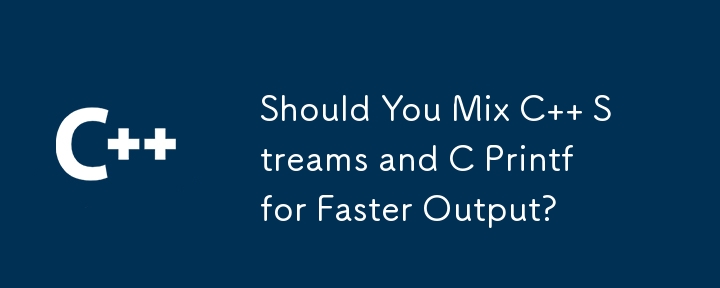Home >Backend Development >C++ >Should You Mix C Streams and C Printf for Faster Output?
Should You Mix C Streams and C Printf for Faster Output?
- Mary-Kate OlsenOriginal
- 2024-11-05 20:18:02520browse

Mixing C Stream and C Printf for Enhanced Output Performance
It has been observed that the C function printf often surpasses the C stream function cout in terms of output speed. While this difference may vary based on implementation, it has been noted that printf can be significantly faster in certain scenarios. To leverage this advantage, a combination of these printing methods can be employed, where cout is used for simple printing while printf is leveraged for large outputs.
To ensure smooth transitions between the two methods, it is crucial to flush the stream buffer before switching printing techniques. This is demonstrated below:
cout << "Hello" << endl;
cout.flush();
for (int i = 0; i < 1000000; ++i) {
printf("World!\n");
}
fflush(stdout);
cout << "last line" << endl;
cout << flush;
Performance Evaluation
While the above approach is functionally valid, its efficiency has been a topic of debate. A series of performance tests were conducted to assess the effectiveness of various optimization techniques. The results revealed the following:
- printf/puts emerge as notably faster than cout when writing to the NUL device. However, cout maintains competitiveness when outputting to real files.
- Several proposed optimizations, such as fill_n, provide minimal performance enhancements.
- Avoiding the use of endl is by far the most impactful optimization to improve output speed.
- cout.write yielded the fastest execution times, although the margin may not be substantial.
Based on these observations, it is evident that judicious use of printf for large outputs, coupled with the avoidance of endl, can significantly enhance output performance. While optimization techniques may vary in effectiveness, careful consideration of these tips can lead to notable improvements in code efficiency.
The above is the detailed content of Should You Mix C Streams and C Printf for Faster Output?. For more information, please follow other related articles on the PHP Chinese website!
Related articles
See more- C++ compilation error: A header file is referenced multiple times, how to solve it?
- C++ compilation error: wrong function parameters, how to fix it?
- C++ error: The constructor must be declared in the public area, how to deal with it?
- Process management and thread synchronization in C++
- How to deal with data splitting problems in C++ development

